Why Your Free Time In Retirement Doesn’t Feel Right.

What are the chances that the following statement would be found in any of a financial planner’s training manuals?
“Ironically, jobs are actually easier to enjoy than free time, because like flow activities they have built-in goals, feedback rules, and challenges, all of which encourage one to become involved in one’s work, to concentrate and lose oneself in it. Free time, on the other hand, is unstructured, and requires much greater effort to be shaped into something that can be enjoyed.”
This little slice of advice comes from Hungarian-American psychologist Mihaly Csikszentmihalyi (henceforth, for obvious reasons, referred to as Mr. C), considered one of the co-founders of positive psychology and originator of the psychological concept of “flow”, a highly focused mental state conducive to productivity.
When you’ve been hanging out in the self-development world for multiple decades and plowed through several hundred books in that genre as I have, you are bound to bump into Mr. C repeatedly and his concept of “flow”.
 You may be more familiar with another common description of “flow”. It’s often called “being in the zone”. It’s Michael Jordan going off for the playoff record 63 points; it’s a pro-golfer shooting 59; it’s you when you become so immersed in something you love that time disappears and the work just simply flows without much effort.
You may be more familiar with another common description of “flow”. It’s often called “being in the zone”. It’s Michael Jordan going off for the playoff record 63 points; it’s a pro-golfer shooting 59; it’s you when you become so immersed in something you love that time disappears and the work just simply flows without much effort.
In Mr. C’s words, flow is “a state in which people are so involved in an activity that nothing else seems to matter; the experience is so enjoyable that people will continue to do it even at great cost, for the sheer sake of doing it”
He went on to say: “The best moments usually occur when a person’s body or mind is stretched to its limits in a voluntary effort to accomplish something difficult and worthwhile.”
That’s the “flow” mental state.
When he published his book “Flow” in 1990, his findings pushed back against conventional wisdom. That conventional wisdom, which still prevails today, is that relaxation will make us happy. Less work and more leisure are what we want.
Mr. C’s research revealed that we have that wrong. He found that people were happier at work and less happy relaxing than they suspected. The more “flow” experiences a person has in a week or month the higher the person’s life satisfaction.
He takes this perspective further:
“Ironically, jobs are actually easier to enjoy than free time, because like flow activities they have built-in goals, feedback rules, and challenges, all of which encourage one to become involved in one’s work, to concentrate and lose oneself in it. Free time, on the other hand, is unstructured, and requires much greater effort to be shaped into something that can be enjoyed.”
Human beings, it appears, are at their best when engaged deeply in something challenging.
Boredom ahead
As I’ve engaged soon-to-be-retired executives with my retirement coach hat on, many express concern about becoming bored. They know that going from 110 miles an hour to a near full stop isn’t going to work for them. Several post-retirement execs have confirmed that it’s a legitimate concern.
Steve, a newly retired hospital CEO, found his new free time a nice change. But after a year he began to miss some of the challenge, identity, and structure that came with his high-profile management role.
He had no shortage of volunteer activities come his way but found most of them “shallow” in nature, lacking the type of “deep work” he had been accustomed to and that occasionally took him to a flow state.
We talked about a “middle-ground”, finding a project that he valued enough that he could see himself experiencing a taste of the deep work he retired from and balancing it with taking advantage of the new free time. He has a shortlist of projects under consideration.
It occurred to me as I revisited Mr. C’s flow state theory that this is a concept that is non-existent in retirement conversations. Can you imagine a financial planner suggesting to a client that s/he should consider remaining in some level of a “deep work” state while retired?
But then, that’s easy to understand why they wouldn’t. Financial planning was started by insurance salesmen and they are trained to sell products. At the core, their goal is to help people move away from that nasty four-letter word called “work”. I suspect there isn’t much training in psychology, the metaphysical, mind/body, or the understanding of the importance of flow in life satisfaction.
My inference is simple: traditional, vocation-to-vacation retirement takes us away from a proven life-sustaining activity – structured, goals-based, flow-state deep work – and into a world that erroneously links relaxation and shallow work to happiness.
The act of going deep orders the consciousness in a way that makes life worthwhile. Flow generates happiness.






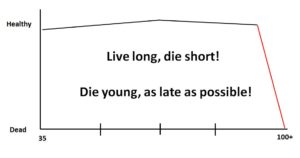

 Let’s ignore the “OK, Boomer” fad and actively engage and listen to these youngsters with an open mind and an understanding that we need them as much as they need us.
Let’s ignore the “OK, Boomer” fad and actively engage and listen to these youngsters with an open mind and an understanding that we need them as much as they need us.


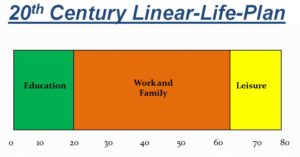 When I do reconnect with Stan, I’m going to remind him that he, like most, is operating under the model of a three-stage life (learn-earn-retire) that “taught us that this is a one-tank journey” where we may “find ourselves running on fumes as we realize it takes two tanks of fuel to propel us to a fulfilling lifelong journey.”
When I do reconnect with Stan, I’m going to remind him that he, like most, is operating under the model of a three-stage life (learn-earn-retire) that “taught us that this is a one-tank journey” where we may “find ourselves running on fumes as we realize it takes two tanks of fuel to propel us to a fulfilling lifelong journey.”
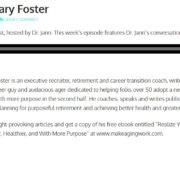

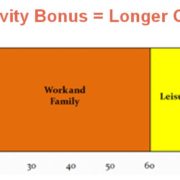
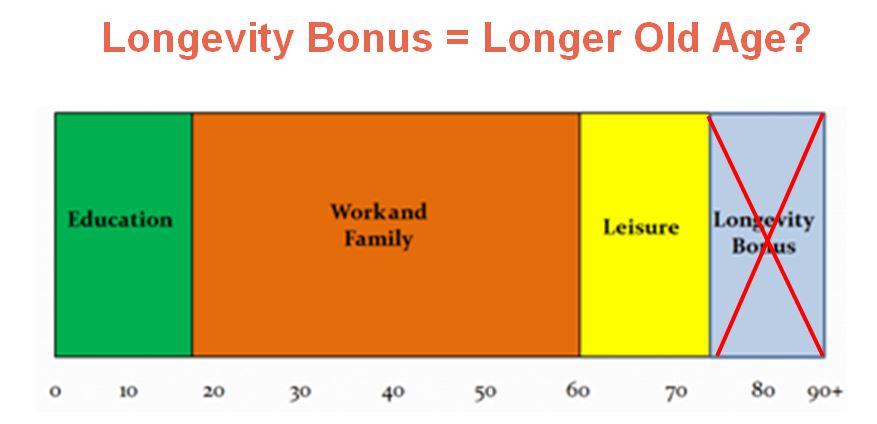
 Without a plan, that’s what it often turns into for those who refuse to give up the traditional learn-earn-retire model that we’ve bought into for the last several decades. You know the one I mean – that old, aging elephant in the room, the one that has those golden years of “every day is Saturday” at the end.
Without a plan, that’s what it often turns into for those who refuse to give up the traditional learn-earn-retire model that we’ve bought into for the last several decades. You know the one I mean – that old, aging elephant in the room, the one that has those golden years of “every day is Saturday” at the end. One common theme I see emerging from these conversations is the visceral “I have plenty to keep me busy”. Catching up on delayed home projects, more family involvement, resurrecting moth-balled hobbies, trying new activities (pickle-ball comes up more often than I expected!).
One common theme I see emerging from these conversations is the visceral “I have plenty to keep me busy”. Catching up on delayed home projects, more family involvement, resurrecting moth-balled hobbies, trying new activities (pickle-ball comes up more often than I expected!). This new terrain can be a bit like trying to negotiate the city of Chicago using a map of Des Moines.
This new terrain can be a bit like trying to negotiate the city of Chicago using a map of Des Moines.






 I’m grateful I got moved off each portal. I just regret that the unbalancing forces didn’t come along sooner and more forcefully, especially in the later stages. But that’s a sob story for another article. It will have “intentional inertia” in the title.
I’m grateful I got moved off each portal. I just regret that the unbalancing forces didn’t come along sooner and more forcefully, especially in the later stages. But that’s a sob story for another article. It will have “intentional inertia” in the title.

 One-hundred-fifty years ago, we had no one telling us that we’ve earned the right to become a body at rest. The incentive to keep moving was called survival and work was the engine. We flipped all that upside down with the Industrial Revolution and intensified the incentive to become inert as we’ve moved through an evolving revolution in the way we work and live.
One-hundred-fifty years ago, we had no one telling us that we’ve earned the right to become a body at rest. The incentive to keep moving was called survival and work was the engine. We flipped all that upside down with the Industrial Revolution and intensified the incentive to become inert as we’ve moved through an evolving revolution in the way we work and live.

 that spoke to how we have, with the help of creative social scientists and enterprising capitalists, expanded from two cultural portals 150 years ago (childhood – adulthood) to seven today (newborn, infancy, childhood, adolescence, young adult, middle age, and old age).
that spoke to how we have, with the help of creative social scientists and enterprising capitalists, expanded from two cultural portals 150 years ago (childhood – adulthood) to seven today (newborn, infancy, childhood, adolescence, young adult, middle age, and old age). I’m a late-stage septuagenarian with a middlescence mindset. Without it, I haven’t got a prayer of getting to my target of living to 112 ½.
I’m a late-stage septuagenarian with a middlescence mindset. Without it, I haven’t got a prayer of getting to my target of living to 112 ½.

 But one thing is certain. Like anything else, if I don’t set the goal, I for sure won’t get there. So what if I miss it by 5 or 10 years? It beats buying into only living to the average U.S.male lifespan of 78.69 years. Especially when you are 77.5, which I am.
But one thing is certain. Like anything else, if I don’t set the goal, I for sure won’t get there. So what if I miss it by 5 or 10 years? It beats buying into only living to the average U.S.male lifespan of 78.69 years. Especially when you are 77.5, which I am.
 Culturally, we’ve been taught to wind down as we age, to come in for a landing after several decades of flying high. A mindset that suggests another take-off and moving into a future that could be bigger than a high-achieving past is foreign to us when, in fact, we are in an ideal position to make our future bigger. Maybe not in title; maybe not in money; maybe not in culturally-perceived prestige. But we can bring and pay forward our talents and acquired skills and experiences to serve others in transformational ways that exceeded what we did in our past.
Culturally, we’ve been taught to wind down as we age, to come in for a landing after several decades of flying high. A mindset that suggests another take-off and moving into a future that could be bigger than a high-achieving past is foreign to us when, in fact, we are in an ideal position to make our future bigger. Maybe not in title; maybe not in money; maybe not in culturally-perceived prestige. But we can bring and pay forward our talents and acquired skills and experiences to serve others in transformational ways that exceeded what we did in our past. Let’s keep it simple. We are 35 trillion cells, give or take a few trillion. Give those cells the oxygen they crave (exercise), the right type of glucose (nutrition) and less cortisol, adrenaline, and norepinephrine (stress reduction), and they’ll do their job to slow the age acceleration.
Let’s keep it simple. We are 35 trillion cells, give or take a few trillion. Give those cells the oxygen they crave (exercise), the right type of glucose (nutrition) and less cortisol, adrenaline, and norepinephrine (stress reduction), and they’ll do their job to slow the age acceleration.


 Passivity is not a good thing to have working for us for what could possibly be nearly a third of our lives.
Passivity is not a good thing to have working for us for what could possibly be nearly a third of our lives.